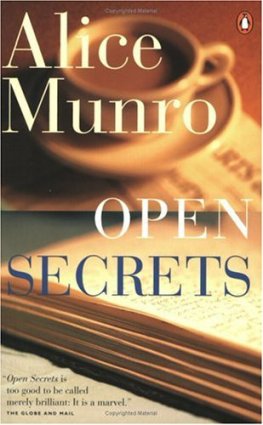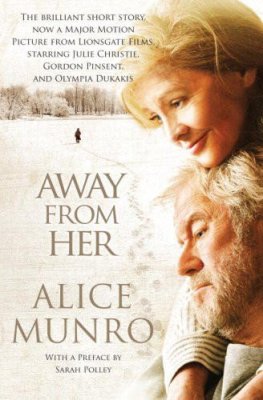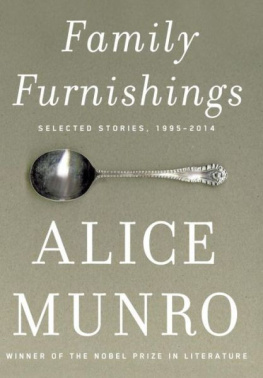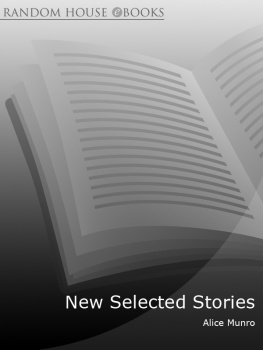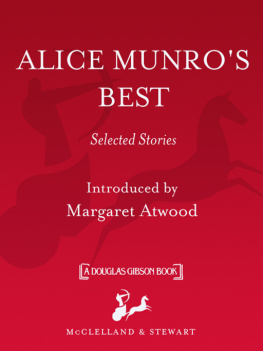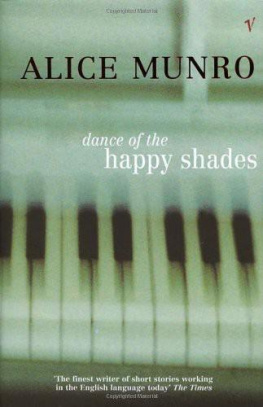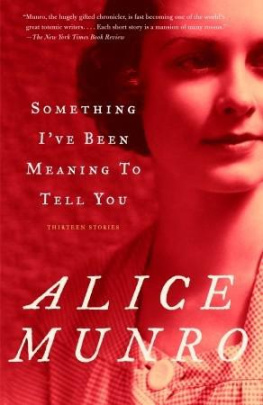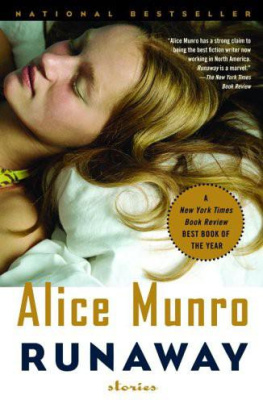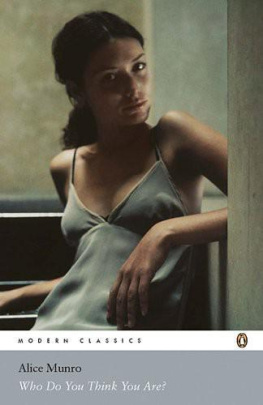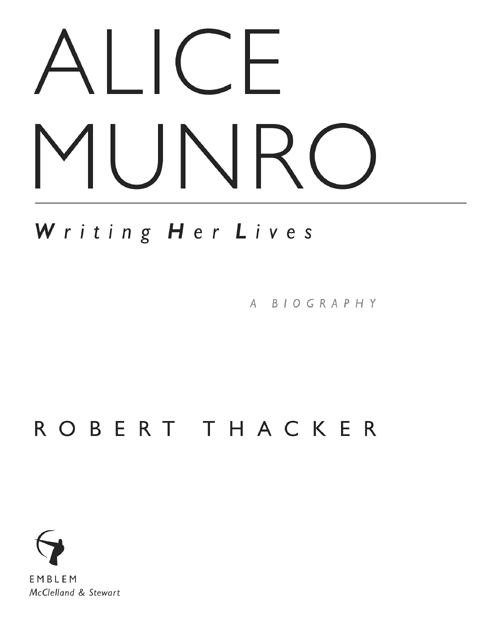Copyright 2005, 2011 by Robert Thacker
Cloth edition published 2005
Emblem edition with new chapter published 2011
Emblem is an imprint of McClelland & Stewart Ltd.
Emblem and colophon are registered trademarks of McClelland & Stewart Ltd.
All rights reserved. The use of any part of this publication reproduced, transmitted in any form or by any means, electronic, mechanical, photocopying, recording, or otherwise, or stored in a retrieval system, without the prior written consent of the publisher or, in case of photocopying or other reprographic copying, a licence from the Canadian Copyright Licensing Agency is an infringement of the copyright law.
Library and Archives Canada Cataloguing in Publication
Thacker, Robert
Alice Munro : writing her lives : a biography / Robert Thacker.
eISBN: 978-0-7710-8468-3
1. Munro, Alice, 1931-. 2. Munro, Alice, 1931 Criticism and interpretation. 3. Authors, Canadian (English) 20th century Biography. I. Title.
PS8576.U57Z885 2011 C813.54 C2010-907896-9
We acknowledge the financial support of the Government of Canada through the Book Publishing Industry Development Program and that of the Government of Ontario through the Ontario Media Development Corporations Ontario Book Initiative. We further acknowledge the support of the Canada Council for the Arts and the Ontario Arts Council for our publishing program.
McClelland & Stewart Ltd.
75 Sherbourne Street
Toronto, Ontario
M 5 A 2 P 9
www.mcclelland.com
v3.1
For Debbie, Mike, and Sue:
Friends of a Lifetime
The walnuts drop, the muskrats swim in the creek.
A Real Life (1992) Open Secrets
Some of these stories are closer to my own life than others are, but not one of them is as close as people seem to think.
Introduction to The Moons of Jupiter (1986)
The story must be imagined so deeply and devoutly that everything in it seems to bloom of its own accord and to be connected, then, to our own lives which suddenly, as we read, take on a hard beauty, a familiar strangeness, the importance of a dream that cant be disputed or explained. Everything is telling you: Stop. Hold on. Here it is. Here too. Remember.
Golden Apples (1999) The Georgia Review
Contents
PROLOGUE

Alice Munro, August 1974
This ordinary place is sufficient, everything here is touchable and mysterious.
Everything Here Is Touchable and Mysterious (1974)
Their daughters, Sheila, twenty, Jenny, seventeen, and Andrea, seven, were at varying stages of independence and dependence. Munro was worried about how the breakup would affect them, especially Andrea, but was pressing ahead. Her new life involved no real plan beyond leaving British Columbia for Ontario. Alice Munro had decided to come home.
Home, despite more than twenty years on the west coast, was still Ontario. Specifically, it was Wingham, Huron County, Ontario the place Alice Ann Laidlaw had left for marriage to James Armstrong Munro and a shared life in Vancouver at the very end of 1951. She was then twenty years old and had completed two years on scholarships at the University of Western Ontario; he was twenty-two, had a general arts B.A. from Western and a job at Eatons department store in Vancouver. Within two years of the marriage, Sheila was born, followed within another two by Catherine, who died the day of her birth; Jenny was born in 1957 and, after a longer interval, Andrea followed in 1966.
Throughout her domestic life as a young wife and mother, Alice Munro wrote. Before she was married, Munro had published stories in Westerns undergraduate literary magazine, Folio, and she had made contact with Robert Weaver, an arts producer at the CBC , who bought and broadcast Munros The Strangers in October 1951. This was the first of a succession of stories broadcast there, and throughout the 1950s these were complemented by magazine publication in Mayfair, the Canadian Forum, Queens Quarterly, Chatelaine, and the Tamarack Review. The 1960s saw more commercial and little magazine publication, with the Montrealer emerging then as Munros most frequent venue, and the possibility of a book gradually became real. Dance of the Happy Shades was published by Ryerson Press in 1968, winning Munros first Governor Generals Award and, three years later, in 1971, Lives of Girls and Women appeared from McGraw-Hill Ryerson.
To this point Munros writing was solitary, personal, private, something she did not talk about nor, really, much share with Jim Munro, although throughout their years together he remained supportive of her writing. When stories were finished, they went out to be considered for broadcast or publication. They often came back. Throughout most of Munros time living in British Columbia, as she later wrote, Robert Weaver was almost the only person I knew who had anything to do with the world of writing. This changed as time passed and Munros stories continued to appear, but for a long time Weaver who besides his work at the CBC also held the leading editorial post at the Tamarack Review was, she wrote, one of the two or possibly three people who took my writing seriously. Yet a writer was what she really was, engaged always in a wooing of distant parts of herself, as one of her narrators characterizes the process. That was her real work. Yet to the world, she was a housewife and a mother. After Jim quit his job at Eatons and the family moved to Victoria to open Munros Books in 1963, Alice was known there as the wife of the man who ran the bookstore. Only gradually did the people she knew there learn that Munro wrote for a long time very few people in Victoria were aware that she had published anything.
But all this changed in the early 1970s when Munro began her long voyage from the house of marriage and headed east to Ontario to stay, going home to the place she started out from. To make it easier on the children, Munros leave-taking from Victoria was prolonged. It involved departures and returns for a time she lived elsewhere in Victoria, going home to prepare meals and be with her daughters. She spent much of the summer of 1972 in Toronto with Andrea, and in 1973, she and her daughters were in Nelson, in the British Columbia interior, while Munro taught a summer-school course in creative writing at Notre Dame University. That fall she was living in London with Jenny, commuting once a week into Toronto to teach at York University. She was also preparing Something Ive Been Meaning to Tell You for the press.
Something would prove to be Munros last book with McGraw-Hill Ryerson. She had remained with Ryerson with some misgivings after a large U.S. firm, McGraw-Hill, bought it in 1970; this decision to stay was made largely out of loyalty to Audrey Coffin, her Ryerson editor who had moved to McGraw-Hill Ryerson. Unlike its predecessor, Lives of Girls and Women, Something offers no pretense of a single point of view it is an eclectic collection of stories, including The Found Boat, which dates from Munros 1950s attempts to write a conventional novel, along with some of the most singular, striking stories she has ever written, such as Material and The Ottawa Valley. The former offers a caustic critique of a writers pretensions while at the same time celebrating that persons genuine gift (an act of magic an act, you might say, of a special, unsparing, unsentimental love. A fine and lucky benevolence).


